Direct Observation of Cu Clusters and Dislocation Loops by Cs-Corrected STEM in Fe-0.6wt%Cu Alloy Irradiated in BR2
Abstract
:1. Introduction
2. Experimental Procedures
3. Results
3.1. Dose Dependence of Microstructure and Hardness
3.2. Dislocation Loops and CRPs Formed in Fe-0.6wt%Cu Alloy and A533B
4. Discussion
5. Conclusions
Author Contributions
Funding
Acknowledgments
Conflicts of Interest
References
- Odette, G.R. On the dominant mechanism of irradiation embrittlement of reactor pressure vessel steels. Scr. Mater. 1983, 11, 1183. [Google Scholar] [CrossRef]
- Lucas, G.E.; Odette, G.R.; Lombrozo, P.M.; Sheckherd, J.W. Effects of Radiation on Materials: 12th International Symposium; ASTM STP 870; American Society for Testing Materials: Philadelphia, PA, USA, 1985; p. 900. [Google Scholar]
- Fuji, K.; Ohkubo, T.; Fukuya, K. Effects of solute elements on irradiation hardening and microstructural evolution in low alloy steels. J. Nucl. Mater. 2011, 417, 949–952. [Google Scholar] [CrossRef]
- Takeuchi, T.; Kuramoto, A.; Kameda, J.; Toyamam, T.; Naai, Y.; Hasegawa, M.; Ohkubo, T.; Yoshiie, T.; Nishiyama, Y.; Onizawa, K. Effects of chemical composition and dose on microstructure evolution and hardening of neutron-irradiated reactor pressure vessel steels. J. Nucl. Mater. 2010, 402, 93–101. [Google Scholar] [CrossRef]
- Lindgren, K.; Boasen, M.; Stiller, K.; Efsing, P.; Thuvander, M. Evolution of precipitation in reactor pressure vessel steel welds under neutron irradiation. J. Nucl. Mater. 2017, 488, 222–230. [Google Scholar] [CrossRef]
- Suzuki, M.; Onizawa, K.; Kizaki, M. Effects of Radiation on Materials: 17th International Symposium; ASTM STP 1270; American Society for Testing Materials: Philadelphia, PA, USA, 1996; p. 351. [Google Scholar]
- Odette, G.R.; Mader, E.V.; Lucas, G.E.; Phythian, W.J.; English, C.A. Effects of Radiation on Materials: 16th International Symposium; ASTM STP 1275; American Society for Testing Materials: Philadelphia, PA, USA, 1993; p. 373. [Google Scholar]
- Kiritani, M.; Tanaka, H. Dynamic studies of defect mobility using high voltage electron microscopy. J. Nucl. Mater. 1978, 69–70, 277–309. [Google Scholar] [CrossRef]
- Hirsch, P.; Howie, A.; Nicholson, R.; Pashloy, D.; Whelan, M. Electron Microscopy of Thin Crystals; Butterworths: London, UK, 1965; pp. 263–267, (loop nature); pp. 415–418 (thickness measurements). [Google Scholar]
- Kiritani, M.M.; Yoshida, N.; Tanaka, H.; Maehara, Y. Growth of interstitial type dislocation loops and vacancy mobility in electron irradiated metals. J. Phys. Soc. Jpn. 1975, 38, 1677–1686. [Google Scholar] [CrossRef]
- Yoshida, N.; Kiritani, M.; Fujita, F.E. Electron radiation damage of iron in high voltage electron microscope. J. Phys. Soc. Jpn. 1975, 39, 170–179. [Google Scholar] [CrossRef]
- Abe, H.; Kuramoto, E. Interaction of solutes with irradiation-induced defects of electron-irradiated dilute iron alloys. J. Nucl. Mater. 1999, 271–272, 209–213. [Google Scholar] [CrossRef]
- Tobita, T.; Nakagawa, S.; Takeuchi, T.; Suzuki, M.; Ishikawa, N.; Chimi, Y.; Saitoh, Y.; Soneda, N.; Nishida, K.; Ishino, S.; et al. Effects of irradiation induced Cu clustering on Vickers hardness and electrical resistivity of Fe-Cu model alloys. J. Nucl. Mater. 2014, 452, 241–247. [Google Scholar] [CrossRef]
- Nagai, Y.; Tang, Z.; Hasegawa, M.; Kanai, T.; Saneyasu, M. Irradiation-induced Cu aggregations in Fe: An origin of embrittlement of reactor pressure vessel steels. Phys. Rev. B 2001, 63, 134110. [Google Scholar] [CrossRef]
- Vincent, E.; Becquart, C.S.; Domain, C. Ab initio calculations of self-interstitial interaction and migration with solute atoms in bcc Fe. J. Nucl. Mater. 2006, 359, 227–237. [Google Scholar] [CrossRef]
- Bacon, D.J.; Kocks, U.F.; Scattergood, R.Q. The effect of dislocation self-interaction on the Orowan stress. Philos. Mag. 1973, 28, 1241–1263. [Google Scholar] [CrossRef]
- Queyreau, S.; Monner, G.; Devincre, B. Orowan strengthening and forest hardening superposition examined bydislocation dynamics simulations. Acta Mater. 2010, 58, 5586. [Google Scholar] [CrossRef]
- Lucas, G.E. The evolution of mechanical property change in irradiated austenitic stainless steels. J. Nucl. Mater. 1993, 206, 287–305. [Google Scholar] [CrossRef]
- Bergner, F.; Pareige, C.; Hernendez-Mayoral, M.; Malerba, L.; Heintze, C. Application of a three-feature dispersed-barrier hardening model to neutron-irradiated Fe-Cr model alloys. J. Nucl. Mater. 2014, 448, 96–102. [Google Scholar] [CrossRef]
- Russell, K.E.; Brown, L.M. A dispersion strengthening model based on differing elastic moduli applied to the iron-copper system. Acta Metall. 1972, 20, 969–974. [Google Scholar] [CrossRef]
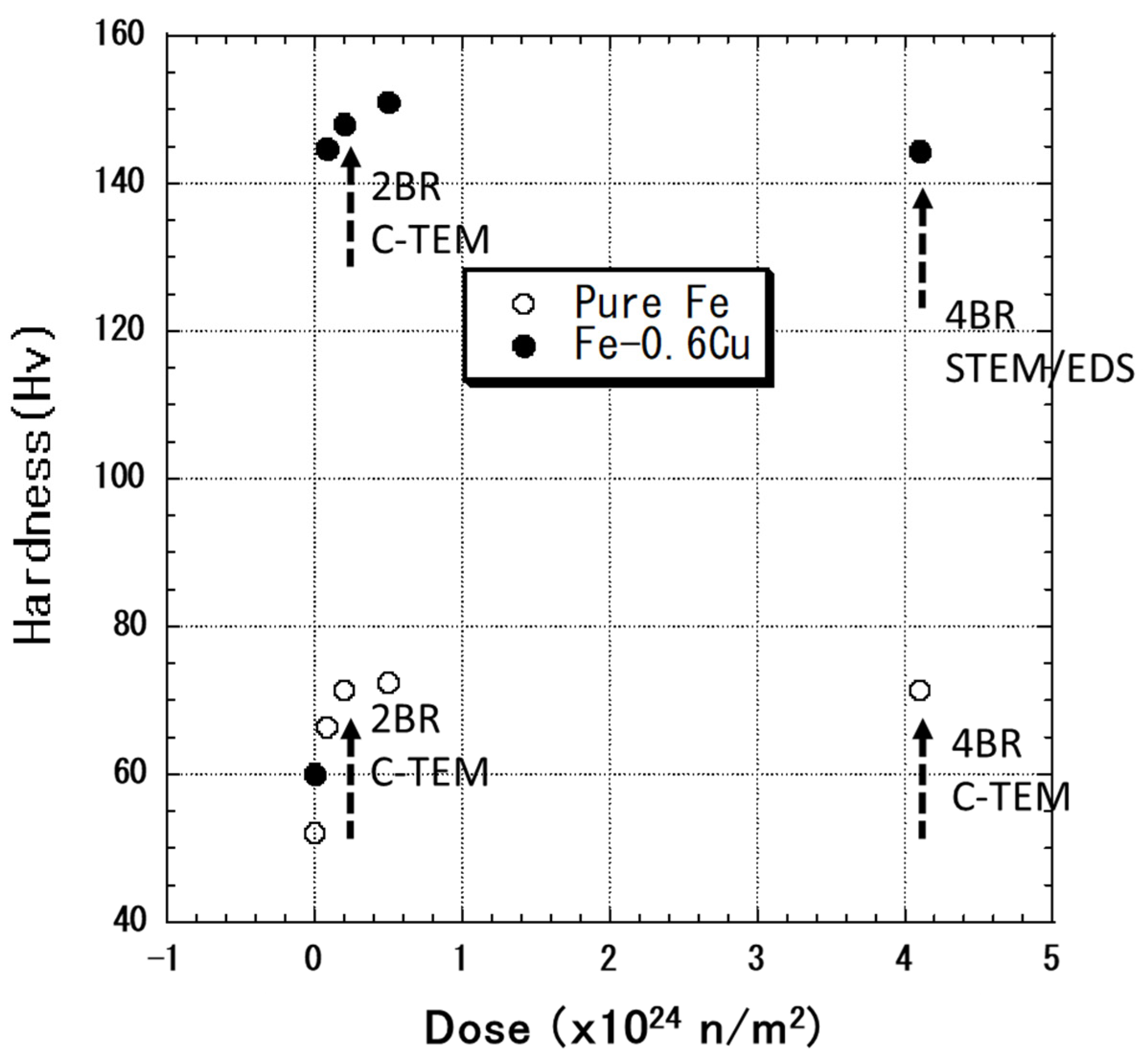
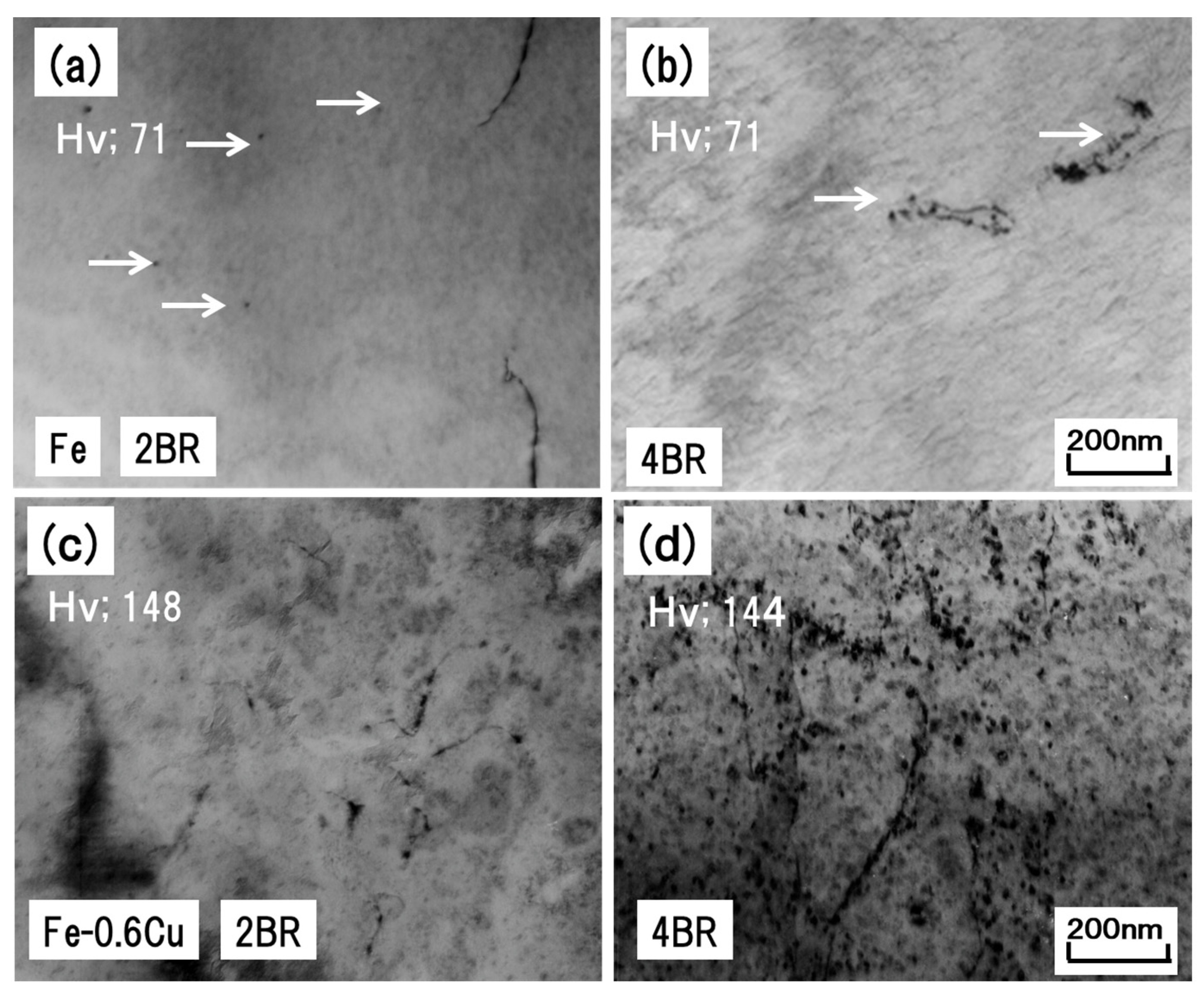



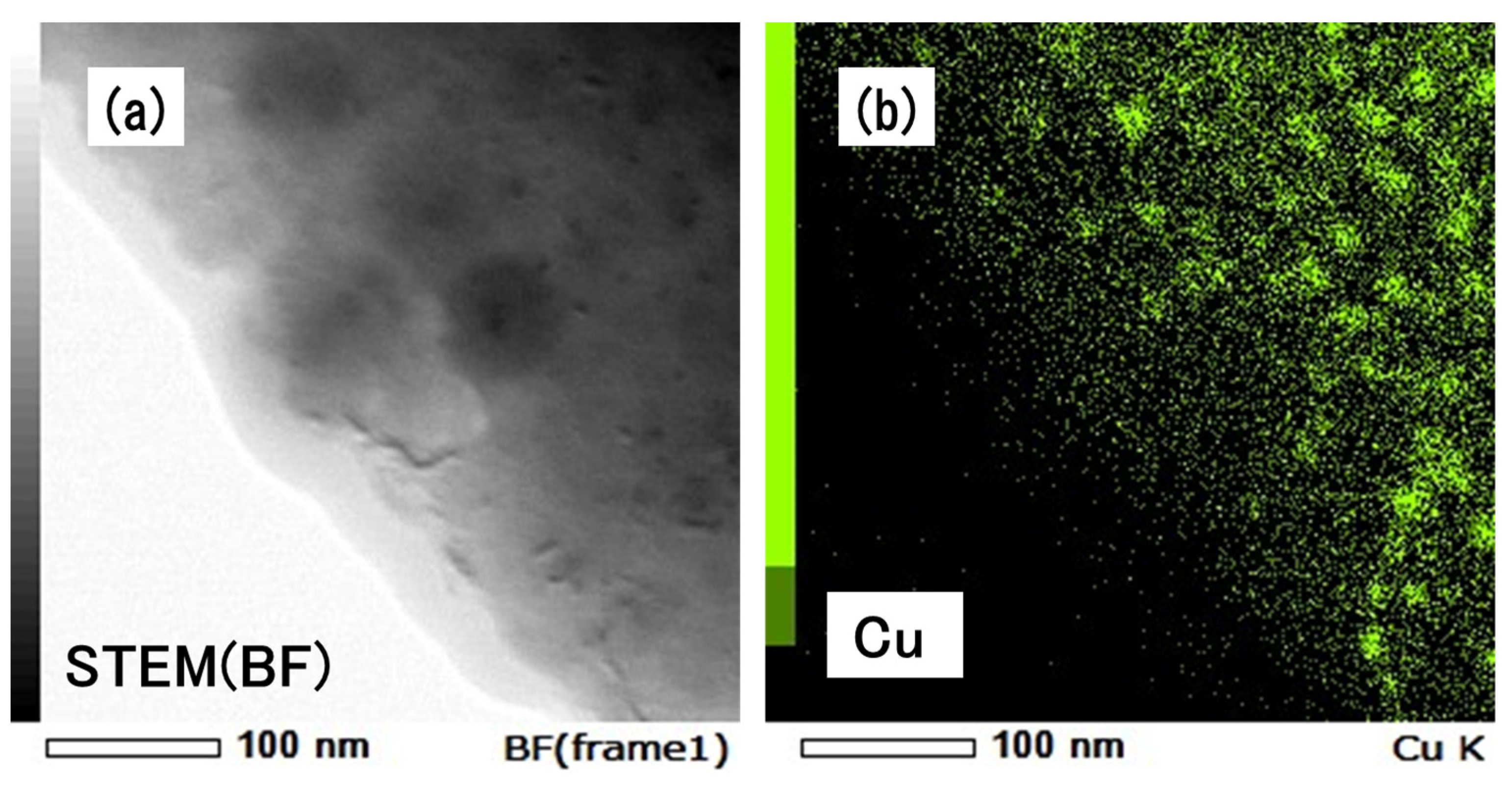
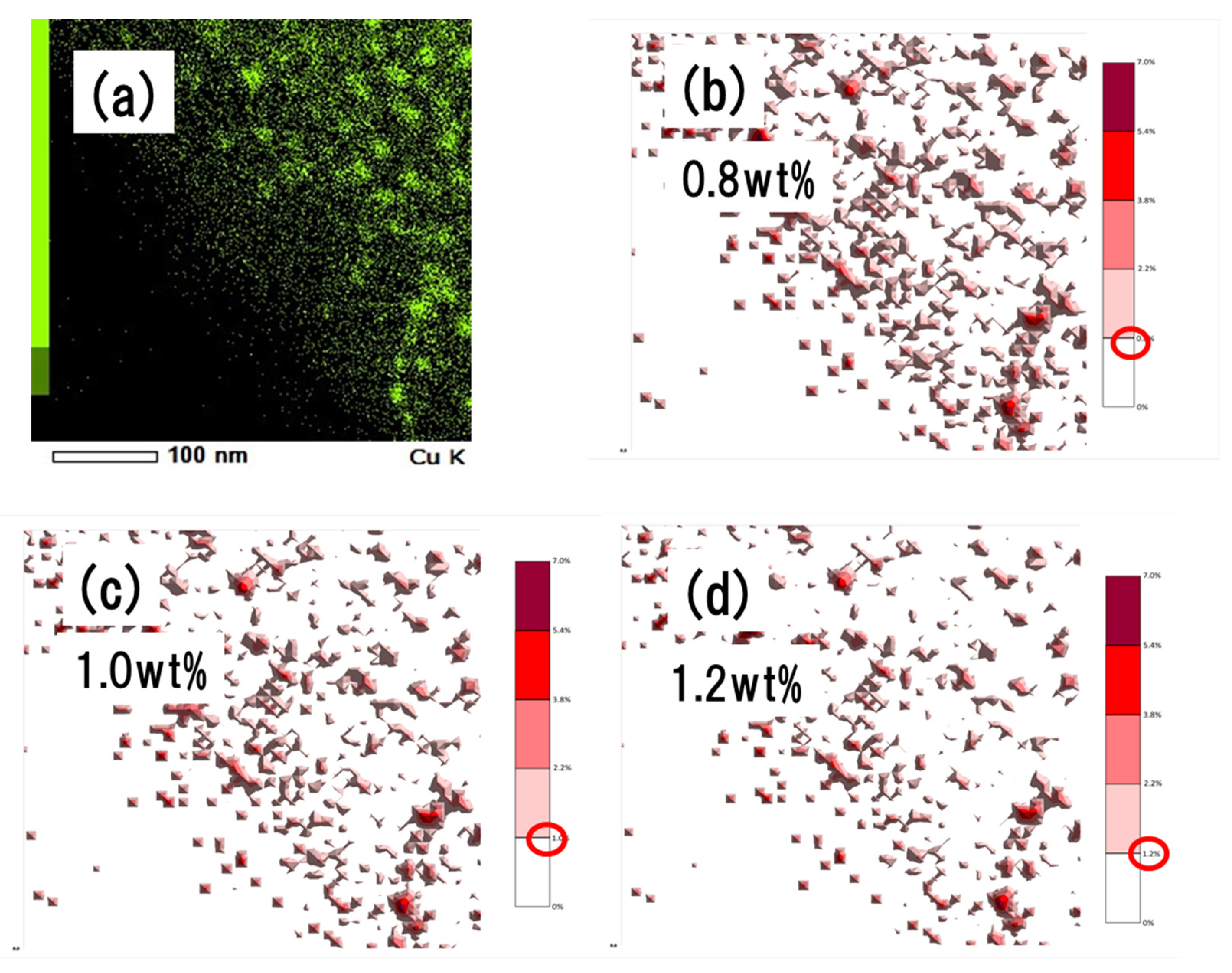
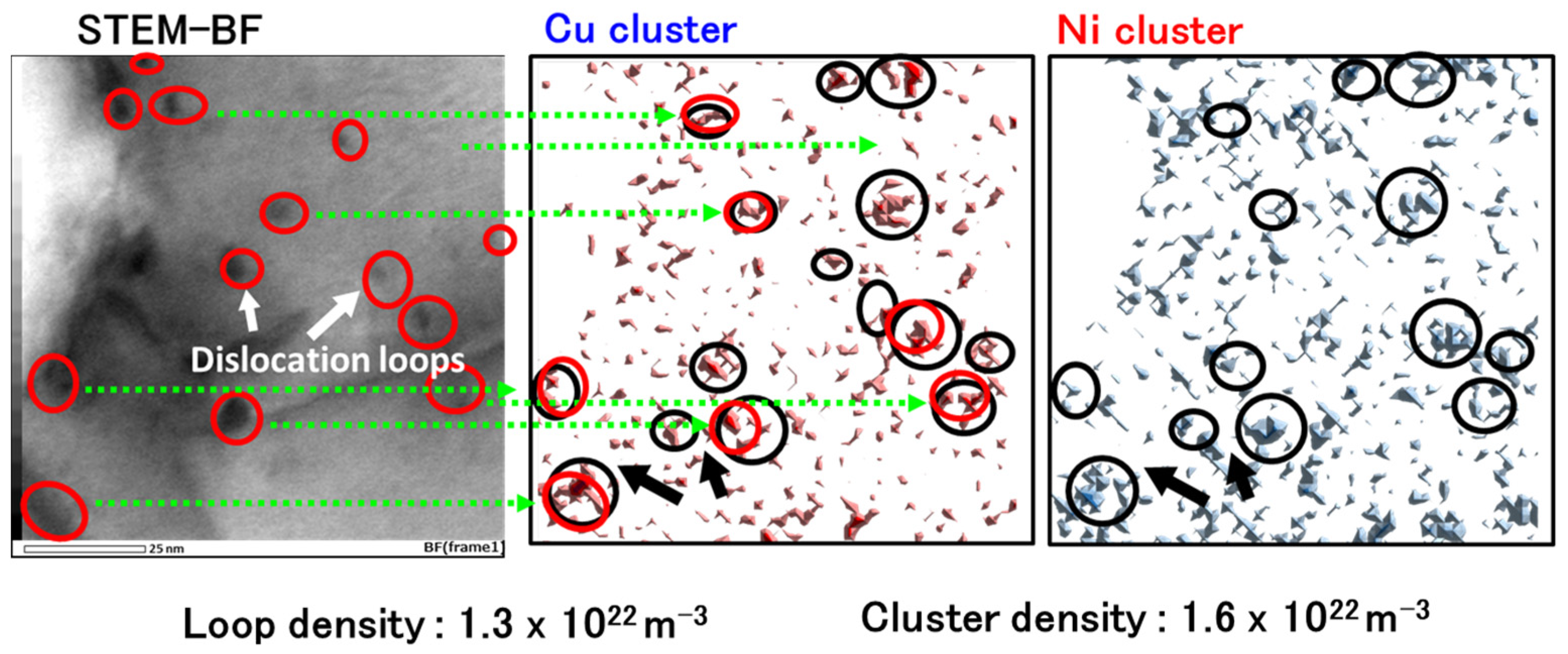
| Materials | Nominal Composition(wt%)/Impurities |
|---|---|
| Pure Fe | <30 ppm C |
| Fe-0.6Cu | 0.6 Cu (<30 ppm C) |
| A533B steel | 0.14 C, 0.003 S, 0.017 P, 0.19 Si, 1.47 Mn 0.64 Ni, 0.14 Cr, 0.51 Mo, 0.164 Cu |
| Irradiation Cycle | Fluence (n/m2) |
|---|---|
| 06M-1BR | 8.3 × 1022 |
| 06M-2BR | 2.0 × 1023 |
| 06M-3BR | 5.0 × 1023 |
| 06M-4BR | 4.1 × 1024 |
Publisher’s Note: MDPI stays neutral with regard to jurisdictional claims in published maps and institutional affiliations. |
© 2022 by the authors. Licensee MDPI, Basel, Switzerland. This article is an open access article distributed under the terms and conditions of the Creative Commons Attribution (CC BY) license (https://creativecommons.org/licenses/by/4.0/).
Share and Cite
Watanabe, H.; Tanaka, T.; Turu, T.; Kamada, Y. Direct Observation of Cu Clusters and Dislocation Loops by Cs-Corrected STEM in Fe-0.6wt%Cu Alloy Irradiated in BR2. Metals 2022, 12, 729. https://doi.org/10.3390/met12050729
Watanabe H, Tanaka T, Turu T, Kamada Y. Direct Observation of Cu Clusters and Dislocation Loops by Cs-Corrected STEM in Fe-0.6wt%Cu Alloy Irradiated in BR2. Metals. 2022; 12(5):729. https://doi.org/10.3390/met12050729
Chicago/Turabian StyleWatanabe, Hideo, Tomonari Tanaka, Takuya Turu, and Yasuhiro Kamada. 2022. "Direct Observation of Cu Clusters and Dislocation Loops by Cs-Corrected STEM in Fe-0.6wt%Cu Alloy Irradiated in BR2" Metals 12, no. 5: 729. https://doi.org/10.3390/met12050729
APA StyleWatanabe, H., Tanaka, T., Turu, T., & Kamada, Y. (2022). Direct Observation of Cu Clusters and Dislocation Loops by Cs-Corrected STEM in Fe-0.6wt%Cu Alloy Irradiated in BR2. Metals, 12(5), 729. https://doi.org/10.3390/met12050729





